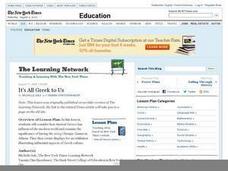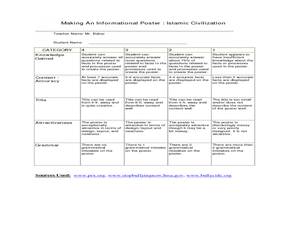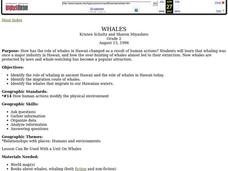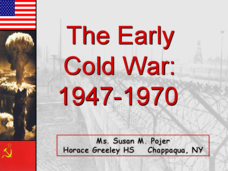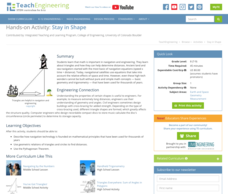Curated OER
Paper: Scientific Inquiry Through Chinese Art
Students create replicas of Chinese hanging scrolls in an attempt to understand the technology behind the creation and use of paper in Ancient China. This three-day lesson includes enrichment ideas.
Curated OER
It's All Greek to Us
Students examine the various ways in which ancient Greek culture has influenced modern-day life. They study the context in which modern-day Greeks consider the 2004 Summer Olympics by reading and discussing the article "Where It All...
Curated OER
Mysteries of Egypt
Students investigate the Egyptian civilization. In this cultural lesson plan, students watch the film Mysteries of Egypt and create a replica of an ancient Egyptian artifact.
Curated OER
Resolving Conflict Lesson : Islamic Civilization
Students explore the spread of Islam in ancient civilizations. In this Islam instructional activity, students research and discuss the Muslim beliefs, stereotypes, and history. Students write essays that address the topic and create...
Curated OER
Hellenistic World
In this Classical period learning exercise, students read over 2 pages of notes about Hellenistic culture and then highlight the important details.
Curated OER
Whales
Second graders identify the role of whaling in ancient Hawaii and the role of whales in Hawaii today, identify the migration route of whales and identify the whales that migrate to our Hawaiian waters.
Curated OER
Finding Latitudes and Longitudes
Pupils analyze Columbus' rationale for sailing west, and find the latitude and longitude of modern and ancient place names.
Curated OER
Maya Math: From Zero to Nineteen
Students explore counting methods of the ancient Maya, and practice identifying Maya number glyphs.
Curated OER
Experimental Archaeology: Making Cordage
Students make a cordage and use an activity sheet to experience a skill that ancient Native American in North Carolina neded for everyday life.
Curated OER
Where The Blue Fern Grows
Students discuss ancient plants and their adaption in the world. Students review forms of plant propagation. Given proper supplies and directions, students apply a variety of fern spores to peat pellets, monitor the growth, and...
Curated OER
Understanding Greek Mythology
Students explore the role of Greek mythology in ancient Greek life. They discuss the origins of the Greek gods and goddesses, conduct Internet research, and present a project in the form of a dialogue between a Greek god and a human...
Curated OER
NOVA scienceNOW-Profile: Brothers Chudnovsky: Moving Images
Students examine digital images of the Unicorn tapestry. They discover why the Chodnovsky brothers had a difficult time piecing together digital scans of three-by-three-foot sections of ancient tapestry.
Curated OER
The Early Cold War: 1947-1970
With a combination of images, maps, and valuable information, this presentation is a strong resource for a history class that is coming out of a WWII unit and into a Cold War unit. Some points are outlined for students, while others are...
Curated OER
Cave Paintings
Students examine various types of prehistoric art. In groups, they research the purpose of the drawings and use the internet to research the various ancient human groups. To end the lesson, they draw animals compared to the prehistoric...
Curated OER
The Art of the Italian Renaissance
Feast your eyes on some of the most beautiful and important art of the Renaissance, including paintings, sculptures, and architecture. The slides take care to detail the characteristics of each art form, but the presentation really lends...
Teach Engineering
Weather Forecasting
According to the Farmers' Almanac, the weather will be nice today. Class members examine how weather forecasting plays a part in their lives with a resource that provides information on the history of forecasting, from using cloud...
Global Oneness Project
After the Quake: Preserving the Artifacts of Kathmandu
On April 28, 2015, a 7.8 earthquake ruptured the Kathmandu Valley in Nepal. Seven UNESCO World Heritage sites are located in this valley. The efforts of experts and archeologists to restore three of them—Kathmandu Durbar Square, Patan...
Federal Reserve Bank
The Legacy of the Olympics: Economic Burden or Boon?
Do the economic benefits of major sporting events such as the Olympics or the World Cup outweigh the expected costs? Using fundamental economic terms, discover the explicit and implicit costs and benefits for countries that host these...
Curated OER
Volcanoes: Second Grade Lesson Plans and Activities
Young geologists explore volcanoes with a series of engaging geology activities. First, they learn the difference between magma and lava before coloring and labeling the parts of a volcano. During the lab, individuals watch a...
National Energy Education Development Project
Exploring Oil and Gas
The United States consumes more oil than any other country, about 1.85 billion barrels (or 77 billion gallons) a day. Viewers learn about the history of fossil fuel exploration and how they are formed in an informative presentation. They...
EngageNY
The Opposite of a Number
It's opposite day! The fourth installment of a 21-part module teaches scholars about opposites of integers and of zero. Number lines and real-world situations provide an entry point to this topic.
Deliberating in a Democracy
Marriage and the State
What defines marriage in society? Scholars investigate the moral and legal arguments of what defines marriage. They analyze different marriage traditions and social customs around the world along with Supreme Court decisions. Individuals...
Teach Engineering
Stay in Shape
Using their knowledge of right triangles, pupils find out how far a ship is from a light house. Class members determine how far around the world a ship would be sailing at a constant speed.
K12 Reader
Absolute Location
Where in the world are we? As a reading comprehension exercise, kids read a short passage about navigation using latitude and longitude, and then respond to a series of questions based on the article.



